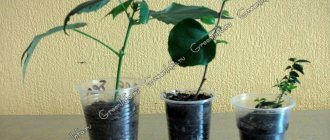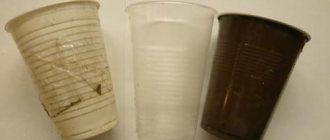Many people dream of propagating their favorite rose bush. June-July is the best time to do this easily and simply using cuttings.
Candidate of Biological Sciences Lyudmila Uleyskaya , who worked at the Nikitsky Botanical Garden (Crimea) for more than 30 years, will tell you about all the nuances of rose cuttings. Currently, Lyudmila is a consultant for the Gardener and Gardener magazine and a number of online publications.
According to the expert, rooting of cuttings should be carried out within a certain time frame:
- for greenhouse roses from a bouquet - from March to April;
- for open ground roses - from the second half of June to the end of July.
The optimal temperature for rooting is 22-25°C (sharp fluctuations should not be allowed).
Humidity – 90-100%.
Lighting – diffused sunlight.
Not all types of garden roses take cuttings well. Climbing, miniature, ground cover and many varieties of polyanthus roses and floribunda almost always take root. Hybrid teas are worse (especially varieties with dark red and yellow colors) and develop weaker than grafted ones.
So, let's look at all the stages of rose cuttings.
Rose propagation methods
Roses can be propagated mainly in three ways: by seed, vegetatively (which includes propagating roses by cuttings from a bouquet (cut stem), dividing bushes, suckers and layering) and grafting or budding.
The second method of propagation is also called cuttings. The output rose bushes from the first two types of propagation are self-rooted, that is, with their own roots, and not from rose hips. They are grown more quickly, with much less labor and planting material invested.
It should be noted that if the ground part freezes, the bush of self-rooted roses will be completely renewed.
However, they have both advantages and disadvantages. Self-rooted roses develop more slowly, are initially less resistant to unfavorable environmental conditions, and for the first two years their root system is more superficial, and therefore there is a risk of freezing without covering the roses for the winter.
The propagation of roses by cuttings and grafting is widely used in both industrial and amateur floriculture. Such types of rose breeding as: dividing bushes, suckers and layering are less popular, since few varieties of roses are capable of such propagation.
Seed propagation of roses is used for growing miniature and polyanthus roses, rose hips, as well as in breeding work. In the future, we will consider all the methods.
Features of growing a queen of flowers from a bouquet
Certain nuances of reproduction:
- For rooting, you should choose cuttings with insufficiently blossomed buds.
- Cuttings with red and pink flowers are more reliable in propagation. White, yellow, and orange roses have no chance to take root.
- When growing shoots in winter, it is necessary to provide additional lighting and optimal air humidity.
- Sometimes even an established cutting dies after a while.
Advantages and disadvantages of cuttings
Advantages of propagation by cuttings:
- Minimum expenses. There is no need to buy expensive seedlings. You can get a lot of planting material from one bush.
- No wild growth.
- High survival rate when planted in open ground.
- Variety of options.
Rooting roses in pots - necessary conditions
Planting cuttings directly into the ground is a traditional method of flower propagation. To do this, you need to prepare a small container - a plastic pot, a glass or a cut-off bottle. Disinfect the vessel with a concentrated solution of potassium permanganate and dry it. At the bottom it is necessary to put drainage in the form of pebbles, polystyrene foam or expanded clay material. Then you should lay out a layer of soil (garden soil with compost) and a small amount of sand (2 cm).
To successfully grow roses from cuttings using this method, the soil in the pot must be loose and fertile. If desired, flower growers fertilize the soil with peat or calcine it in the oven. At high temperatures, harmful microorganisms and weed seeds will die.
The prepared soil should be moistened, the cutting should be placed in it with a diagonal cut to the sand line, watered and pressed down with earth. Cover the seedling with a glass jar or bag on top. The cuttings can be planted vertically on the ground or at an angle, both options will give good results. If several shoots are planted in one box at once, they should be placed at a distance of 7 cm.
Over the next 3-4 weeks, water the plants as the soil dries out; sometimes they can be sprayed. The temperature in the room where the cuttings germinate should be in the range of +18 - +23 degrees. At the stage of sprouts appearing in the leaf axils, begin to accustom future roses to fresh air. From time to time, remove the jar from the flower; every day you need to increase the repetitions. When the cutting gets used to the new conditions, the shelter is removed for good. The rose will be ready for planting in the ground after green shoots appear.
An interesting option is rooting in newspapers
Sheets of newsprint are moistened, but not to such an extent that water flows from them or they come apart. The cuttings are completely wrapped in damp paper, possibly several sheets. Next, the bundles are placed in a plastic bag and tied, in order to obtain a greenhouse effect.
Keep the cuttings in a cool place. Newspapers are changed periodically, the main thing is not to allow them to dry out completely.
It is likely that after a couple of weeks, seals will form on the stems - the beginnings of roots. After this, roses can be planted in pots with soil.
What to do if a rose has sprouts or leaves
Peonies in a vase
The rose in the vase has given new leaves, what should I do? What should you do if a rose sprouts shoots in a vase? These questions arise if some new parts grow from a cut flower. If there are only leaves, it will not be possible to extend the life of the rose, but if roots have appeared, then you can try to replant it in the soil. However, if the plant is imported, it will not be able to take root, as it will not survive the winter.
Also, those flowers that have been standing for more than a month will not be able to take root, as they are treated with chemicals. The flower will not be able to grow without chemical feeding. Summer cuttings take root best.
Care
Although the rose is considered a rather capricious plant, it is not difficult to care for. The main thing is to observe the frequency of watering and the light regime, since it is extremely sensitive to this. The rose should be in a bright place, but direct sunlight should not burn it. If you leave the plant in shade or partial shade, the buds will simply become crushed or even degenerate.
It is worth watering the rose regularly, but in moderation. Excess moisture will lead to rotting of the root system and death of the plant.
The air in the room should not be too dry. In summer it is better to leave the rose on the loggia or open veranda.
Care during the cold season
In winter, care is somewhat special. The rose should not be overheated, so you definitely can’t leave it on the windowsill above hot radiators. Ideally, the pot should be placed in a room where the temperature is no higher than +15°C, but in most cases this is impossible to do. Another way out is frequent ventilation so that cold air reaches the plant.
In autumn, with the onset of cold weather, the rose needs to be pruned so that no more than 4-5 buds remain on each shoot. The resulting cuttings can be rooted and planted. Watering should be reduced to once every 5–7 days.
You need to fertilize the rose at the beginning of the period of active growth, every 2 weeks. You can use both general-purpose fertilizers purchased at the store and a solution of bird droppings.
Otherwise, the picture of caring for roses is no different, as when growing other types of indoor plants.
Growing cuttings in water
Rooting cuttings in water is the easiest and most popular way to propagate roses. Try to get spring or rain water. If this is not possible, use tap water, but boiled or filtered in advance. A chlorinated environment is dangerous for shoots; the plant will simply die. You can also add a little charcoal to raw water; its antiseptic properties prevent flowering.
Place a container of water in any place where access to direct sunlight is blocked. An ordinary glass jar is suitable for this purpose, because through the transparent glass you can observe the process of root development. Some gardeners cover the neck of the container with film and make holes in it. This method is practical because the leaves will not touch the water and will not rot. The cuttings themselves should not touch the bottom of the vessel: this will cause them to rot.
Add a small amount of fertilizer to the water, this will increase the likelihood of good growth of the cuttings.
The water in the container needs to be changed every two days. After 2-3 weeks, whitish or light green growths form on the cuts; later, roots will develop from them. Experienced gardeners advise keeping the cuttings in water for a couple more days so that the root system strengthens even more. But this is not always beneficial for the plant: due to the low concentration of oxygen in the water, the flowers may rot. In any case, keep an eye on the cuttings; after 15-20 days, they can be transplanted into the ground.
Inspection of the flower
You need to carefully examine the flower from the bud to the leaves.
All parts must be fresh: the cutting must not be dry, because it simply will not sprout; the bud must be fresh and young, with a rich color.
The middle part of the stem is well suited, since it is unlikely that it will be possible to grow cuttings from the upper cuttings, because when growing many varieties, the buds located in the axils of the leaves are simply removed.
Preparation rules
- Choose your favorite rose from the bouquet. Trim flowers and unopened buds.
- Cut the stems into rods 15-20 cm long. Move 1 cm down from the lower bud, make a sharp cut at an angle. At a distance of 1.5 cm up from the lower second bud, make a straight cut, which is covered with candle wax. The remaining shoots are also cut.
- Remove all thorns and all lower leaves from all samples. Shorten the top ones by a third.
- Dilute the growth stimulator in a container with clean water. Dip the cuttings 1/3 of their length into the solution. Soak for 6 hours. You can't overexpose it.
How to propagate a flower in an apartment by cuttings?
Inventory and materials
- Sharp garden pruning shears, pre-disinfected with manganese or alcohol solution.
- Pots or plastic containers. The pot must have drainage or drain holes so that the watered soil does not retain moisture, as the cutting may rot.
- Covering material: glass jars, cut plastic bottles, plastic film.
Preparing the soil and pots
The rose cuttings need to be rooted in loose, fertile soil. You can root roses in plastic containers or buckets, in wooden boxes and in flower pots.
Important! The soil should be nutritious and well-drained. It is prepared from 2 parts of turf soil, 1 part of clean river sand and 1 part of humus or peat.
Drainage is placed at the bottom of prepared containers, then prepared soil is poured in and another 3 cm of sand is poured on top for better air circulation. Sand prevents the formation of a crust on the surface of the earth.
Before planting the cuttings, the soil must be spilled with a solution of Fitosporin or potassium permanganate for disinfection. The drug Glyokladin is also used, which prevents the formation of root rot. It is enough to bury just 1 tablet of this drug 2 cm into the soil.
Cutting planting material
- To make a cutting, you must first remove the lower leaves.
- You should leave 3 buds on the cutting.
- Under the first lower bud, step back 2 cm and make an oblique cut (an oblique cut is made to obtain a larger rooting area, and also to avoid confusing the top and bottom).
- From the top of the cutting above the third bud, retreat 1 cm and make a straight cut. The cut must be made with a sharp knife or pruning shears, previously disinfected in potassium permanganate or an alcohol solution.
Cuttings should not be broken off or left with a torn edge. It is not recommended to trim with scissors, as they will only crush the fibers of the stem. The top leaves should be left, they will show whether the cutting has taken root or not. The trimmed cuttings must be carefully inspected to ensure that there is no damage or pests. The stems should be no thinner than 4mm and no thicker than 6mm. The length of the cutting should be 17-20cm.
Processing the top and bottom of the cut
Important! Before planting, the lower part of the cutting must be treated with stimulants for the formation and growth of roots.
Kornevin is suitable for this, in which the lower cut is dipped and immediately planted in the ground. You can hold the bottom of the cuttings in a solution of Heteroauxin (5 mg per 100 ml of water) or Zircon (5 drops per 1 liter of water).
Good results are obtained by soaking in a honey solution; for this, 1 teaspoon of honey is diluted in a glass of water. Aloe juice is also a natural stimulant. All stimulants are left for 24 hours. The top of the cut can be dipped in wax to prevent rotting. The thorns need to be removed.
How to plant?
After the rose cuttings have been processed, you can plant them in prepared containers. The container should be deep and spacious enough.
- At the bottom of the container you need to put expanded clay or pebbles in a layer of 5 cm.
- Pour the prepared soil, adding perlite or vermiculite to it for looseness and moisture retention. You can mix the prepared soil with rose mixture purchased at the garden center. It is useful to add sphagnum moss to the mixture. It has a beneficial effect on the rooting process and prevents the cuttings from rotting.
- Using a spray bottle, lightly moisten the soil.
- Make vertical holes with a stick at a distance of 9-10cm from each other.
- Dip the lower cut of the cutting in water and Kornevin and insert it into the holes so that the cutting does not reach the drainage layer. The second and third buds should be above ground level in the pot or planting container. The cuttings need to be planted at a slight angle; it is believed that this will allow rooting to take place better. Kornevin will promote active root growth. Compact the soil well around the planted cuttings and water a little with manganese solution.
How to root?
For reliable rooting, planted rose cuttings need to create high air humidity - 80-90%. To do this, each cutting is covered with a cut plastic bottle or a common greenhouse is made. The top leaves remaining on the cuttings should not touch the shelter. This creates a microclimate for rapid root formation.
The plastic bottles used to cover the cuttings must be transparent. If you take a large container for germination, then it is better to build a greenhouse over it, that is, cover the box with polyethylene.
For the first 20 days, to maintain moisture, the plants and soil must be sprayed every 3 days. It is recommended to ventilate in the morning and evening. Do not allow strong condensation to form, as the cutting may rot. Rooted cuttings should be kept in a warm and bright place.
Make sure that the containers with planting material are not exposed to direct sunlight, as the branches may get burned.
Advice! To prevent rot, you can periodically water the soil with a solution of Fitosporin (1 teaspoon per 1 liter of water).
After another 3 weeks, the microclimate created in the greenhouse must be changed. Containers with cuttings are transferred to the balcony or lowered into the basement for winter storage. The air temperature should be +2-+3 degrees, humidity 60-70%. If the temperature on the balcony becomes lower, the greenhouse must be covered with a blanket.
Some gardeners use potatoes to root rose cuttings. Tubers contain many useful substances and are a source of moisture and food for the cuttings. You need to use healthy tubers. The eyes are removed from them and a hole is made. The stalk is also dipped in Kornevin and inserted into the potatoes. After that, everything is planted in the ground together. They are grown in the same way as without potatoes.
We invite you to watch a video about rooting rose cuttings in potatoes:
How to germinate a rose in winter using potatoes
Medium-sized potatoes should be carefully removed to prevent sprouts from appearing. Next, a recess is made in it; for this you can use a kitchen knife. It is advisable to dip the planting material in dry Kornevin, then place it in the recess. It is recommended to use cuttings whose length does not exceed 20 cm.
Next, we bury the potatoes in the ground and water them with warm, settled water. Thanks to the potato, the cuttings receive:
- constant nutrition;
- protection from harmful microorganisms.
Next, we make a greenhouse using a cut plastic bottle. Next, we spray the stems with warm water every day, watering as the soil dries. Once a week, watering can be done with sweetened water.











